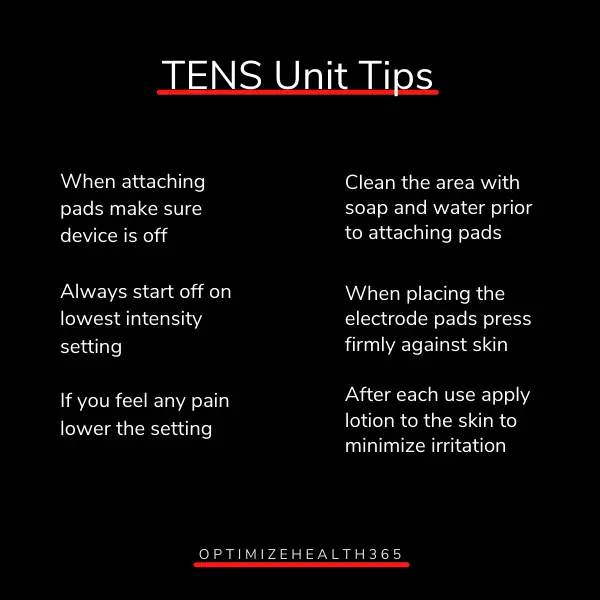Are you curious whether you can use a TENS unit to support your pelvic floor? A TENS (Transcutaneous Electrical Nerve Stimulation) unit is a small battery-operated handheld device that is used to stimulate a certain area of the body using short electrical pulses. By placing the attached electrodes on a certain part of your body, TENS units can help relieve chronic pain in both men and women.
In this article, we are going to explore how both men and women can use a TENS unit to help strengthen or relax their pelvic floor and minimize discomfort in this area.
What is a TENS Unit Used For?
There are many different ways to use a TENS unit, but there are 2 primary uses that are most popular with TENs users.
Alleviate chronic pain
TENS units are usually used for all types of musculoskeletal pain. They are commonly used to alleviate long-term, chronic pain like back pain and joint pain. Many women also are introduced to a TENS unit during labor as it has been proven to help mothers experiencing strong labor pain.
TENS units can help relieve pain for up to 18 hours after treatment, so it is very popular for people dealing with long-term pain.
Combat muscle weakness
Although TENS units shouldn’t be used to strengthen muscles in the same way you would in the gym, they are often helpful when you are trying to stop or reverse muscle weakness.
The stimulation from the electrodes on the TENS unit can be used on a specific area of the body like the pelvic floor or hands or feet where muscle weakness is common.
The electrical pulses from the TENS unit can help the small muscles in these areas contract and regain some much-needed strength that might have been lost due to illness, injury, or age.
Can a TENS Unit Be Used to Strengthen Your Pelvic Floor?
TENS units are a great option for pelvic floor strengthening and training. Depending on your specific circumstance, it can help you learn to engage or relax your pelvic floor muscles. Many men and women turn to them to help alleviate symptoms like general discomfort, incontinence, back pain, and more caused by pelvic floor weakness.
Using a TENS unit will not completely fix all pelvic floor issues, but it can be helpful when learning how to engage (or re-engage) those muscles after lack of use. It’s a great way to teach your body how to activate the muscles and work your way up to strengthening them on your own.
How Do I use a TENS Unit On My Pelvic Floor?
When you’re using a TENS unit to help with pelvic floor strength, the placement of the electrodes and the frequency of use are important factors to consider.
The right way to use the machine on your pelvic floor is also different for men and women. It’s very important to follow the instructions for your specific machine or seek guidance from your healthcare provider if you have questions, but they are pretty easy to use.
Here are the basics of how to use a TENS unit effectively on the pelvic floor for men and women:
TENS Unit Placement for Pelvic Floor for Women
For women, the placement of the TENs unit electrodes for pelvic floor work is similar to men. You should place one electrode on your lower back area just above the top of your buttocks and the other electrode can be placed on your perineum or low on your pubic area.
Depending on the symptoms you are experiencing, you may find that one of the placements works better than the other or that you benefit from both. Try both to utilize a well-rounded approach to strengthening those muscles.



Closely Follow the Instructions
Some TENS units come with only a few settings and others come with a lot more. The TENS devices that have a wide range of settings generally mean you have a broadened degree of control over how intense you want the settings to be.
For chronic and ongoing pain, you should keep your treatment settings somewhere between 2 Hz and 10 Hz. That doesn’t sound like much but it’s great for multiple, small treatments throughout the day when you’re dealing with ongoing, long-term plantar fasciitis.
To deal with moderate pain, set the frequency between 35 Hz and 50 Hz. Acute, high levels of pain may require you to go as high as 80 Hz to 120 Hz. Of course, you have to be careful when adjusting to very high settings.
You’re dealing with very high current, after all, and a TENS device is more than capable of doing the exact opposite of relieving pain. It can even burn the skin if you set it too high. The best method is the experimental one. Adjust the Hz between the settings for the kind of pain you’re dealing with.
Only make small adjustments at a time and allow some time on a single setting to see how your feet feel before you adjust the frequency even higher. The idea is to relieve pain, not create more pain and problems for yourself.
Why Should You Trust Me?

I have extensively used TENS units for neck, shoulder, back and heel pain. I’m certified by Relias Academy in TENS, interferential electrical stimulation, and neuromuscular electrical stimulation (NMES). With over 10 years of TENS unit therapy experience, I feel confident that my recommendations can help you lessen the aches and pains of everyday life.
Using a TENS Unit For Pelvic Floor Issues for Men
For men using a TENS unit to work on pelvic floor weakness or discomfort, you can place the electrodes just above your buttocks/sacral area and either just above the pubic area or directly on your perineum.
Experiment with both placements to see which one works best for you and gives the best results.
The goal is to feel the pulses working your pelvic floor muscles and feel increased strength in that area over time.
Want to know how high you can set a TENS Unit click here to learn more.
How do I Know I Need to Strengthen My Pelvic Floor?
Pelvic floor weakness or loss of strength is something that is rarely talked about. Many men and women find it confusing to identify their pelvic floor muscles and therefore struggle to realize when they have lost strength or are experiencing new symptoms that need addressing.
Does Electrical Stimulation Work for Pelvic Floor?
Electrical stimulation is typically used to help women with recurrent or irritant bladders. This can also assist with pelvis floor strengthening for women with weak vaginal muscles.
Common Signs of Pelvic Floor Weakness:
Signs of Pelvic Floor Weakness in Men
- Frequent urination (incontinence) – If you find yourself running to the bathroom shortly after a trip there, this could be a sign of weakness in the pelvic floor muscles.
- Difficulty passing bowel movements – A strong pelvic floor should have no trouble pushing out stool, so keep an eye on any amount of strain that is more than normal.
- Leaking urine or stool – If you experience leaking of urine or stool, it’s a clear sign that your pelvic floor muscles aren’t strong enough to hold it in until you are ready or able to excrete.
Erectile dysfunction – Although erectile dysfunction could be an indicator of other things, it’s important to look at pelvic floor strength when trying to solve this issue as well.
To learn how to use a TENS unit for erectile dysfunction click here.
Signs of Pelvic Floor Weakness in Women
- Frequent urination (incontinence) – Frequent urination is also a common indicator of pelvic floor weakness in women.
- Pain during intercourse – Many women with pelvic floor weakness report pain ranging from mild discomfort to sharp pain during sexual intercourse.
- Painful menstrual cycles – If you notice that your menstrual cycle has become more painful than you remember it, that may be a sign of pelvic floor weakness.
- Unexplained lower back pain – An onset of lower back pain that can’t be attributed to a specific injury or incident is often a sign of pelvic floor weakness that goes undetected because it is not localized to the pelvis.
Can I Use a TENS Unit on My Pelvic Floor at Home?
One of the best things about using a TENS unit for chronic pain or muscle weakness like pelvic floor issues is that it can be done right at home. You don’t need the guidance of a healthcare provider to start using a TENS unit (although you can seek help from one if you want to).
Most TENS units come with specific instructions on how to use it on different body parts, so make sure to follow the directions on your unit for the best results.
Pelvic Floor Exercises
In addition to a TENS unit doing targeted exercises is a great way to strengthen the pelvic floor muscle. As you can see in the video below you want to lie on your back with knees bent. Raise your hips off the ground then slowly lower your hips until they touch the floor. You can also hold a weight or barbell for a challenging workout.
Final Thoughts
A TENS unit is a great tool to use to treat pelvic floor issues like discomfort or weakness. Both men and women can benefit from the electrode therapy that a TENs unit provides. Many people love using a TENS machine to help them learn how to properly engage and identify their pelvic floor muscles.
Using a TENS unit on your pelvic floor can help strengthen or relax pelvic floor muscles so that they regain normal function and comfort levels. It’s important to only use a TENS unit on your pelvic floor as directed and stop use if you feel like it’s making any of your symptoms worse.





One response to “TENS Unit for Pelvic Floor (Complete Guide for Men & Women)”
[…] Want to learn how a TENS unit can help with your pelvic floor? Click here. […]